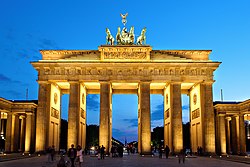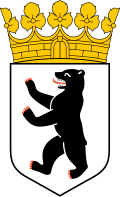Berlin
Berlin (/bɜːrˈlɪn/; German: [bɛʁˈliːn] (![]() listen)[7]) is the capital city of Germany. It is the largest city in the European Union by population, with more than 3.7 million people.[8] The city is in the eastern part of Germany. It is about 70 km (43.50 mi) west of Poland. Berlin has an area of 891 km2 (344.02 sq mi). The rivers Havel, Dahme and Spree run through Berlin. It has an oceanic climate.
listen)[7]) is the capital city of Germany. It is the largest city in the European Union by population, with more than 3.7 million people.[8] The city is in the eastern part of Germany. It is about 70 km (43.50 mi) west of Poland. Berlin has an area of 891 km2 (344.02 sq mi). The rivers Havel, Dahme and Spree run through Berlin. It has an oceanic climate.
|
From top, left to right: Reichstag; Brandenburg Gate; Berlin Cathedral; Charlottenburg Palace; Museum Island and Fernsehturm Berlin; Victory Column; Potsdam Square; Gendarmenmarkt | |
| Coordinates: 52°31′12″N 13°24′18″E / 52.52000°N 13.40500°ECoordinates: 52°31′12″N 13°24′18″E / 52.52000°N 13.40500°E | |
| Country | |
| State | Berlin |
| Government | |
| • Body | Abgeordnetenhaus of Berlin |
| • Governing Mayor | Michael Müller (SPD) |
| Area | |
| • City/State | 891.7 km2 (344.3 sq mi) |
| Elevation | 34 m (112 ft) |
| Population (31 December 2019)[2] | |
| • City/State | 3,769,495 |
| • Urban | 4,473,101 |
| • Metro | 6,144,600 |
| Time zone | UTC+01:00 (CET) |
| • Summer (DST) | UTC+02:00 (CEST) |
| Geocode | NUTS Region: DE3 |
| ISO 3166 code | DE-BE |
| Vehicle registration | B[note 1] |
| GRP (nominal) | €155 billion (2020)[5] |
| GRP per capita | €41,000 (2020) |
| GeoTLD | .berlin |
| HDI (2018) | 0.950[6] very high · 4th of 16 |
| Website | www |
Berlin is home to many famous buildings and monuments, like the Siegessäule, the Brandenburger Tor, the Reichstag and the boulevard Unter den Linden. On the boulevard are the Humboldt University and the State Opera of Berlin. The Governing Mayor of the city is Michael Müller (SPD).
Berlin is a world city of culture, politics, media and science.[9] There are a lot of technology companies in the city. They are important for the city's economy. Many planes and trains travel to and from Berlin because the city is an important place for tourism and business.[10]
Berlin is an important city for the history of Germany. The King of Prussia and the Emperor of Germany lived in Berlin. The government of Germany was in Berlin for many years. Bombs destroyed many buildings in the city in World War Two. The city was split into West Berlin and East Berlin after World War Two. After the Berlin Wall was built in 1961 very few people were allowed to cross from East Berlin into West Berlin. The wall divided the city until 1989 when the East German government decided to allow anyone to cross, and people decided to destroy the wall.
Boroughs
In 2001 the 23 boroughs of Berlin were changed into 12
Sights
- Alexanderplatz (with the Television Tower)
- Berliner Dom (Berlin's cathedral)
- Berlin Hauptbahnhof (the new main Railway station)
- Brandenburg Gate
- Fernsehturm (the TV tower - the highest building in Germany)
- Potsdamer Platz
- Reichstag building (home of the Bundestag)
- Rotes Rathaus (office of the Governing Mayor)
- Straße des 17. Juni (Street of the 17th of June)
- Siegessäule (Statue of Victory)
- Unter den Linden (the main boulevard)
History
- 1244 The first writings about a place called Berlin.
- 1451 The Hohenzollern family moved to Berlin as the place to rule their country
- 1618 – 48 After the Thirty Years' War in Germany, the number of people that lived in Berlin dropped to only 6000.
- 1701 Berlin became capital of Prussia.
- 1709 Berlin and its neighbor city Cölln (not Köln/Cologne) are combined to form the new Berlin.
- 1806 The army of Napoleon Bonaparte moved into Berlin.
- 1871 Berlin became capital of the German Empire.
- 1920 The Old Berlin and some neighbour towns are combined into "Greater Berlin" (Groß-Berlin).
- 1945 The town is divided into four sectors, used by the allies of World War II. There is a Soviet Sector, an American Sector, a British Sector and a French Sector.
- 1949 After foundation of the two Germanies, the town is still divided. There is now West Berlin and East Berlin.
- 1961 The Berlin Wall was built by the communist government of East Germany between the two halves of Berlin.
- 1990 After German reunification, the Berlin Wall is torn down, and there is only one Berlin again. The new Berlin becomes the capital of one Germany.
Gallery
The Buddy Bear has become an unofficial ambassador for Germany and is a symbol of Berlin.
Sister cities
Berlin has partnerships with 17 cities.[11] Each of the 12 boroughs also has their sister cities, sometimes called twin cities.
|
|
Notes
- ↑ Prefixes for vehicle registration were introduced in 1906, but often changed due to the political changes after 1945. Vehicles were registered under the following prefixes: "I A" (1906 – April 1945; devalidated on 11 August 1945); no prefix, only digits (from July to August 1945), "БГ" (=BG; 1945–46, for cars, trucks and busses), "ГФ" (=GF; 1945–46, for cars, trucks and busses), "БM" (=BM; 1945–47, for motor bikes), "ГM" (=GM; 1945–47, for motor bikes), "KB" (i.e.: Kommandatura of Berlin; for all of Berlin 1947–48, continued for West Berlin until 1956), "GB" (i.e.: Greater Berlin, for East Berlin 1948–53), "I" (for East Berlin, 1953–90), "B" (for West Berlin from 1 July 1956, continued for all of Berlin since 1990).
References
- ↑ "Amt für Statistik Berlin Brandenburg – Statistiken". Amt für Statistik Berlin-Brandenburg (in Deutsch). Retrieved 2 May 2019.
- ↑ "Statistischer Bericht: Einwohnerinnen und Einwohner im Land Berlin am 31. Dezember 2019" [Statistical Report: Residents in the state of Berlin on 31 December 2019] (PDF). Amt für Statistik Berlin-Brandenburg (in Deutsch). pp. 4, 10, 13, 18–22. Retrieved 8 April 2020.
- ↑ citypopulation.de quoting Federal Statistics Office. "Germany: Urban Areas". Archived from the original on 3 June 2020. Retrieved 28 January 2021.
- ↑ "Bevölkerungsanstieg in Berlin und Brandenburg mit nachlassender Dynamik" (PDF). statistik-berlin-brandenburg.de. Amt für Statistik Berlin-Brandenburg. 8 February 2019. Retrieved 24 November 2019.[dead link]
- ↑ "Bruttoinlandsprodukt – in jeweiligen Preisen – 1991 bis 2020". www.statistikportal.de.
- ↑ "Sub-national HDI – Area Database – Global Data Lab". hdi.globaldatalab.org. Retrieved 13 September 2018.
- ↑ Kleiner, Stefan; Knöbl, Ralf; Mangold, Max (2015). Das Aussprachewörterbuch (7th ed.). Berlin: Duden. p. 229. ISBN 978-3-411-04067-4.
- ↑ "Amt für Statistik Berlin Brandenburg - Statistiken". www.statistik-berlin-brandenburg.de. Archived from the original on 26 December 2018. Retrieved 25 June 2017.
- ↑ "Archived copy" (PDF). Archived (PDF) from the original on 29 June 2014. Retrieved 25 June 2017.
{{cite web}}: CS1 maint: archived copy as title (link) - ↑ Berlin Beats Rome as Tourist Attraction as Hordes Descend. https://www.bloomberg.com/news/articles/2014-09-03/berlin-beats-rome-as-tourist-attraction-as-hordes-descend. Retrieved 2017-06-25.
- ↑ "Berlin's international city relations". Der Regierende Bürgermeister von Berlin, Referat IV B. Archived from the original on 22 August 2008. Retrieved 9 November 2007.
Other websites
| Wikimedia Commons has media related to Lua error in Module:Commons_link at line 62: attempt to index field 'wikibase' (a nil value).. |
- - German page www.berlin.de
- Berlin Sightseeing Tours
- digital Berlin
- EXBERLINER - English City Magazine
- Berlin City Panoramas - Panoramic Views and virtual Tours of Berlin
- WorldFlicks in Berlin: Photos and interesting places on Google Maps Archived 2009-10-25 at the Wayback Machine






















